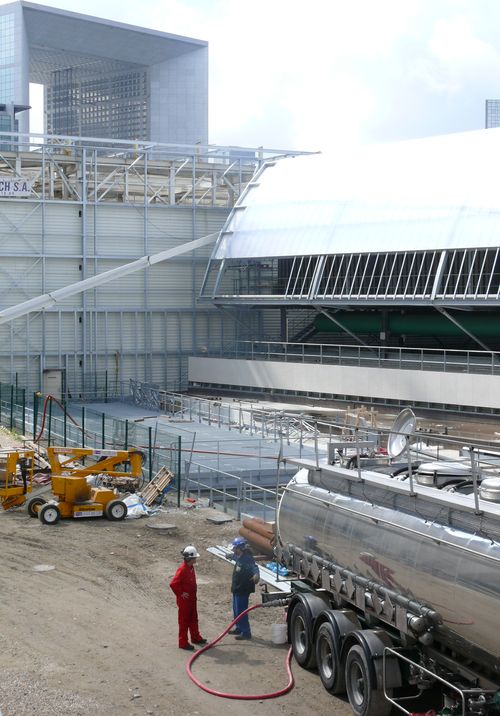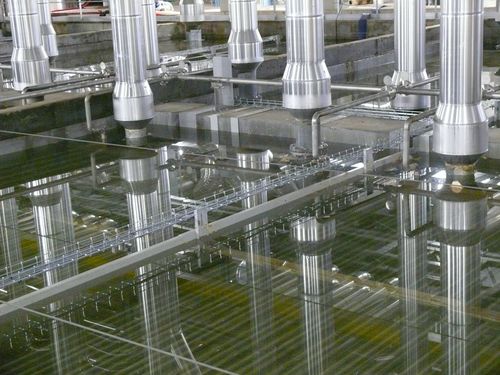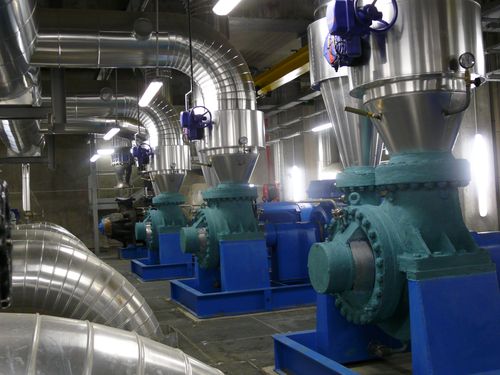Climalife teams delivered 136 cubic metres of pure Friogel, especially adapted to meet the requirements of low temperature refrigeration plant. This heat exchanging substance is intended to maintain a reserve of cold energy in the form of ice stocks. The plant services offices and dwellings in the ‘Défense’ Quarter of Paris, France.
The Enertherm Corporation entered into a programme of works extending over four years for modernising the heating- and air conditioning systems at a business park in the ‘Défense’ Quarter of Paris, France. The renovation work of the central plant at the Alençon Site (Courbevoie), will enable an integration of a central ‘heating’ system in an urban environment and the optimisation of the production of iced water for the air conditioning system.
Optimum Functioning
The Enertherm Corporation selected Climalife to supply the 136 cubic metres of pure sanitary quality glycol (brand name ‘Friogel‘) which, after dilution, will be able to feed the 405 cubic metres of the ice production network.
“Climalife is a referential name on the market, and a major supplier thanks to its specialist knowledge of products and its long-term experience “– Mr. Patrick Davigo, managerial representative of the Enertherm Corporation.
 The works were conducted in two phases: the first during last April with a delivery charge of 82 cubic metres of pure Friogel, and the second in May, for supplementing the remaining 54 cubic metres in the network.
The works were conducted in two phases: the first during last April with a delivery charge of 82 cubic metres of pure Friogel, and the second in May, for supplementing the remaining 54 cubic metres in the network.
The plant functions by diluting glycol down to 33% to 35% to obtain an average temperature of -15 °C. The inclusion of corrosion inhibitors prolongs the useful service life of the piping and tubing. The new ice production aggregates enable ice to be produced and stored cold during the night in six reservoir basins. Withdrawals are made during the day to meet the demand for the supply of iced water. The new refrigerant enables the various points of requirement to be better addressed and optimises the system and streamlining consumption.
Each basin holds a volume of around 1,000 cubic metres of water and is able to supply up to 12 MW of refrigerated power rating. The circulation of glycolised water at -7 °C in the multi-tubular heat exchanger aggregates submerged in the reservoir basin enables a progressive freezing of the water in the basin (around 4 cm of ice per each storing pin).
During withdrawals, the iced water (0°C) is pumped through the various user units via a heat exchanger, then reheated and returned to the basin. The total volume of glycolised water used is 405 cubic metres and around 34 cubic metres per trough of ice.
‘The refrigerated energy of the six basins represents the largest stock in Europe, with its 240 MWh’, emphasised Mr. Stéphan Duclos, the engineering manager responsible for industrial installations.
Refrigeration Production
Iced water network: 14 km
Total refrigerated power rating: 132 MW
Number of refrigeration aggregates: 15
Stock of ice: 6 basins at 40 MWh
being a total of 240 MWh
Production: around 10,000 cubic metres per hour
Output temperature: 4°C to 5°C
Input temperature: around 14°C
Fluid Refrigerant Charge
Glycolised water: 136,000 litres of undiluted sanitary quality glycol (Friogel)
Flexible piping: 60 metres
Delivery: 1 aggregate of motorised pumps of 7 bar output pressure.
HGV Tanker deliveries: 3 rounds
Production: 14 cubic metres per hour.
Enertherm (Corporation)
Business objects: management unit of the concession for urban heating and air conditioning in the ‘Défense’ Quarter of Paris, France
Workforce: 72
Incorporated: 2001
Key to photos
Photo 1 – Storage and distribution basin for iced water ; Photo 2 – Discharging of glycol in the central production facility of iced water ; Photo 3 – Feeder pumps to the network.


